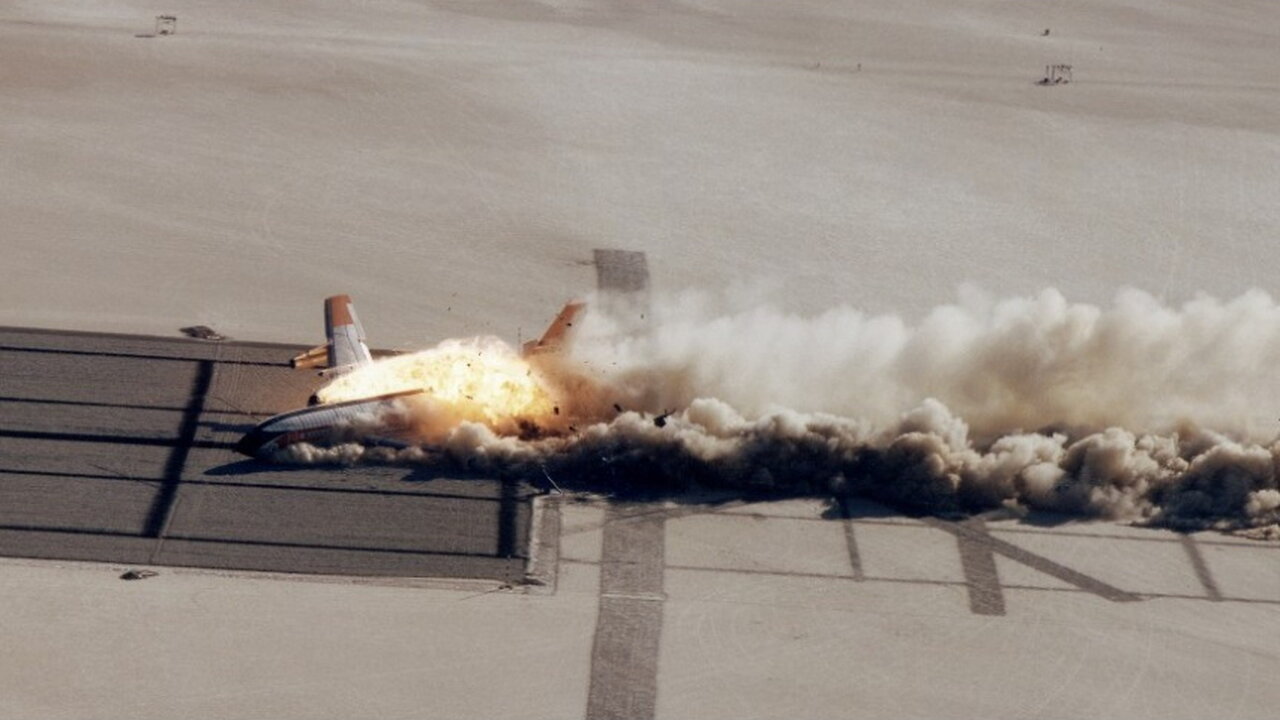Premium Only Content

Boeing 720 Controlled Impact Demonstration (CID), 1984
This video with no sound shows footage of the first remotely piloted air-to-ground crash test of a transport category aircraft, jointly conducted by NASA and the FAA back in 1984. For this purpose, a Boeing 720, the short-haul version of the Boeing 707, had been chosen.
Previous experience had shown that a number of aircraft accidents could actually be survivable, but post-crash fire constituted the biggest threat for the lives of passengers and crew. A 'survivable' accident is defined as one in which the airframe, seat/restraint system, and cabin environment remain reasonably intact, and the impact forces experienced by the occupants are within the limits of human tolerance.
The primary interest of the FAA was the demonstration of an antimisting fuel additive's performance (AMK - antimisting kerosene) with a modified fuel system. Demonstration of improved crashworthy aircraft-design features was a secondary objective for the FAA.
The B-720 was the largest remotely piloted research vehicle ever flown at that time. The pilot was sitting in a ground cockpit allowing to fly an airplane using telemetry and radar. The plan was to touch down short of the runway with the landing gear up. Obstacles were in place to slice through the wings, and a series of approach lights along the runway were supposed to serve as a potential source of ignition.
The aircraft took off from the dry lake bed of Rogers Lake, Edwards Air Force Base, California, in the morning of December 1, 1984 with 76,000 pounds / about 11,000 gallons of AMK fuel on board for a short local flight of less than 10 minutes. The crash occurred at 09:22:11 a.m. at a speed of 149 knots (171 mph / 276 km/h). The surface of the lake bed, though dusty, is as hard as concrete.
The impact went not as planned and was much more severe than in the scenario. The aircraft was about 50 feet to the right of centerline. The left outboard engine made undesired contact with the ground, causing the aircraft to yaw 40° to the left. First contact with the wing opining obstructions was made by the right inboard Number 3 engine. One tenth of a second later, ignition occurred on the inboard or left side of the engine. The cutter also severed the fuel and oil supply lines. The cutter then broke loose and rotated upward into the Number 3 main fuel tank. The total time from the initial contact of the Number 1 engine (left outboard) until the aircraft came to a rest was 11 seconds.
The demonstration was a setback for the antimisting kerosene (AMK) researchers. The fire crews started fighting the fires approximately 90 seconds after the time of impact. The crews continued to spray the fire with foam for over an hour and a half. The impact demonstrated that there are conditions in which the jet fuel antimisting additive is not sufficient to prevent a post-crash fire.
The second part of the experiment, the structural crashworthiness, was generally successful. The impact itself was survivable for most passengers and crew. Among the elements tested were, as one priority, modified seats, burn-through resistant epoxy windows, and also several protected flight data recorders.
Interestingly, the footage made available to the public by NASA apparently has diminished in recent years, and a number of photographs available at the source got redacted for no apparent reason. I decided to create this video in order to preserve as much material as possible for the interested public.
For more information:
- FAA Summary Report -- Full-Scale Transport Controlled Impact Demonstration Program, September 1987
https://ntrs.nasa.gov/api/citations/19880000639/downloads/19880000639.pdf
- NASA Technical Reports Server (NTRS) 19860012462: Full-Scale Transport controlled Impact Demonstration, January 1986
https://archive.org/details/NASA_NTRS_Archive_19860012462/mode/2up
- FAA Report - Antimisting Fuel (AMK) Flight Degrader Development and Aircraft Fuel System Investigation, February 1987
https://archive.org/details/DTIC_ADA182720/mode/2up
-
 LIVE
LIVE
In The Litter Box w/ Jewels & Catturd
20 hours agoExternal Revenue Service | In the Litter Box w/ Jewels & Catturd – Ep. 720 – 1/15/2025
4,837 watching -
 DVR
DVR
Benny Johnson
6 hours ago🚨Confirmation Hearings LIVE Right NOW | Pam Bondi, Rubio, John Ratcliffe & More| Deep State PANIC
158K263 -
 6:04:07
6:04:07
Barry Cunningham
21 hours agoWATCH LIVE: Pam Bondi Attorney General Confirmation Hearing For w/ Nancy Mace Interview
19K14 -
 DVR
DVR
Robert Gouveia
9 hours agoPam Bondi Confirmation Hearing LIVE! Trump's Nominee to FIX Corrupt DOJ as Attorney General
19.5K16 -
 1:57:41
1:57:41
The Quartering
3 hours agoTrump Just FREED Hostages, Pam Bondi Hearing, TikTok To SHUTDOWN, Bill Burr Gets Woke, LA Fires
21.4K40 -
 LIVE
LIVE
Savanah Hernandez
1 hour agoLA Fire Dept withheld 1,000 firefighters ahead of the Palisades Fire
850 watching -
 LIVE
LIVE
Mally_Mouse
2 hours agoLet's Yap About It - LIVE!
328 watching -
 9:25
9:25
Silver Dragons
2 hours agoTop 3 Types of Silver ALL Stackers NEED to Be Buying
49 -
 1:24:04
1:24:04
Russell Brand
4 hours agoPfizer’s $1,000 Bribe to Push Childhood Vaccines – SF520
103K63 -
 1:57:55
1:57:55
The Charlie Kirk Show
3 hours agoThe Confirmation Marathon | Davis | 1.15.2025
112K30